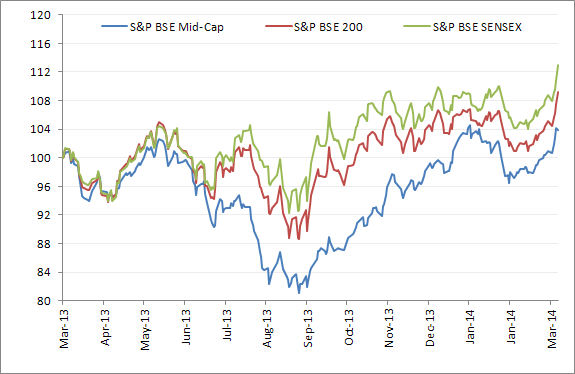
Impact 
Large cap funds have the ability to weather the unfavourable economic conditions as they constitute companies which have established businesses, stable revenues and a high market share. Quite a few large companies dominate the total market capitalisation of any market. And investors often envice interest in them either directly through stocks or by means of largecap oriented mutual funds. They often percieve large caps to be safe and could provide stability to their portfolio in their endevour of wealth creation.

Data as on March 07, 2014
(Source: ACE MF, PersonalFN Research)
But have they created wealth for you?
As you may know, the markets witnessed a fall in the early 2013 due to downbeat macroeconomic variables and weak Indian rupee. However, as the year progressed the market mood turned positive in the last 4 months of calendar year 2013. And in the last 1 year, as can be noticed from the chart above, the S&P BSE SENSEX outperformed the S&P BSE 200 Index and the S&P BSE Mid-Cap Index. This reveals that investor sentiments remained positive towards large cap companies during this period.
Now it is noteworthy that although large cap funds have remained competitive against mid cap, small cap and multi cap funds over the last few years their performance has been unsatisfactory when compared to their respective benchmark indices. In contrast to this, mid and small cap funds, have noticeably outperformed their benchmark indices across all time periods (1 year, 3 year and 5 years) thereby creating alpha as can be seen in the table below:
| Category |
Category Average Returns |
|
1-Yr (%) |
3-Yrs (%) |
5-Yrs (%) |
YTD (%) |
| Large cap Oriented Funds |
11.2 |
6.9 |
20.5 |
3.1 |
| Mid & Small cap Oriented Funds |
15.4 |
10.0 |
28.0 |
2.6 |
| Multi cap Oriented Funds |
11.2 |
6.2 |
21.5 |
2.1 |
| ELSS Funds |
13.5 |
7.7 |
21.9 |
3.0 |
| Value Oriented Funds |
9.5 |
7.1 |
23.9 |
2.4 |
| S&P BSE 100 |
10.4 |
5.7 |
21.4 |
2.6 |
| S&P BSE 200 |
9.2 |
5.0 |
21.4 |
2.3 |
| S&P BSE 500 |
8.7 |
4.5 |
21.3 |
2.1 |
| S&P BSE Mid-Cap |
3.9 |
1.0 |
20.9 |
-0.2 |
| S&P BSE SENSEX |
12.9 |
6.3 |
21.3 |
3.5 |
(Note: The returns less than a year are expressed in absolute terms, while those over a year are expressed in CAGR.)
(NAV Date: March 07, 2014)
(Source: ACE MF, PersonalFN Research)
It is interesting to note that over the last 5 years nearly 59% of the funds in the large cap category have underperformed broader indices such as S&P BSE Sensex and S&P BSE 200. Over the last 1 year as well, more than 2/3rd funds in the large cap category are lagging behind the S&P BSE Sensex Index. However, the performance of mid and small cap funds vis-à-vis their benchmark index is completely opposite. They have outperformed their benchmark return, thereby indeed proving to be a Ferrari in your portfolio. You see, only about 6% of the mid and small cap mutual fund schemes have underperformed the S&P BSE Midcap Index over the last 5 years. Moreover, the quantum of underperformance has remained negligible across the last 1 and 3 year time frames as well.
In this scenario where large cap indices (such as S&P BSE 100 and S&P BSE Sensex) have managed to stay well ahead of midcap indices (S&P BSE Mid-Cap) across all time horizons; funds which consider them as benchmarks have not generated similar returns. This is mainly because although the benchmark index of large cap funds has allocated greater weights to some large cap companies, the large cap oriented mutual funds have maintained a relatively lower exposure to some large cap stocks, possibly being conservative while being diversified. Due to a comparatively lesser exposure, many large cap funds have not benefitted from the rallies in the large cap space as much as their respective benchmark indices have. Also, the mid and small cap oriented funds have been successful at generating market beating returns due to their greater exposure to performing large cap stocks and even capitalising on some momentum plays in the mid and small cap domain. So, despite of being characteristically midcap funds, a higher allocation to performing large cap stocks has enabled them to bear the volatility in market movements and generate notably higher returns as compared to their benchmark.
Mid and small cap funds have further managed to exhibit superior performance across time frames due to their sectoral preferences. Mid and small caps fared well by investing in booming sectors such as Industrials and Consumer Cyclicals. However, large cap funds suffered on this front as they parked their money heavily in sectors which have become unattractive for investors such as financial services and energy /power. Hence returns generated by them have more often than not stayed in line or lagged behind their benchmark returns across time frames.
However does this mean that investors should stay away from large caps and invest only in midcaps? Definitely not. PersonalFN is of the view that although large cap funds have failed in outperforming their benchmark indices noticeably, this cannot be your only criteria in determining where you must invest your hard earned money. The performance of different schemes varies significantly from each other even within the same category. It is imperative that investors consider the long term track record and analyse the potential of funds to generate higher risk-adjusted returns before investing in any mutual fund. Apart from this, your risk appetite and risk tolerance level must also play a significant role before you determine which category of mutual fund (large, mid or smallcap) should you park your hard earned money.
Add Comments